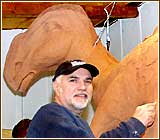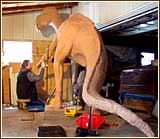A DINOSAUR SCULPTOR PONDERS THE FINAL FORM
Artist John Giannotti Confronts the Great Unknowns of Prehistoric Anatomy
By Hoag Levins ...| ...March 3, 2003


Also see: See More Photos of Sculpture
HADDONFIELD, N.J. -- The latest in a long line of professionals to struggle with the question of how Hadrosaurus foulkii looked and moved, artist John Giannotti spends most of

|
|
Photo: Hoag Levins |
|
|
Keara Giannotti, the artist's daughter, left, and Xiomara Babylonia, right, are part of the team working on the final details of the Hadrosaurus foulkii sculpture.
|
|
his waking hours wrestling with the maddening quandaries of prehistoric reptilian physique.
The issue dominates his daily work space as well -- the old barn he uses for a studio behind his Victorian home in Haddonfield. Pushing through the wooden door, a visitor enters to nearly trip over the massive tail of a creature whose head -- at the other end of the room -- hovers just inches from the ceiling.
Science and art
Giannotti's work is the latest interpretation of how this world-famous fossil would have looked in real life. And, as he stands up to wipe his fingers on a clay-smeared sweatshirt, the sculptor readily acknowledges that his version of the beast is based as much on scientific fact as on common sense and artistic license.
"No one can say exactly what these things looked like -- the bones provide strong clues but not complete information," he says, gesturing up the long, sinuous spine. At the top of that incline an orange clay head is cocked sideways, almost as if looking back warily at the intruding humans below.
"What I've learned is that if you look at this only scientifically, you're making a mistake," he said. "Clearly, there are things going on in this anatomy that are not yet fully understood. After working with them for so long, I've come to 'feel' the bones and the creature in my own way."
Peculiar anatomy
Hadrosaurus foulkii is the milestone fossil find that first showed the world what dinosaurs actually looked like. But even then, it wasn't a precise vision. As he pored over the bones as they came out of the marly muck 145 years ago near Cooper's Creek, the 19th-century father of American paleontology, Dr. Joseph Leidy, sketched a peculiar anatomy combining anatomical features of birds and reptiles. While the basics

|
| Photo: Hoag Levins |
Sculptor John Giannotti is working to make the dinosaur sculpture as scientifically accurate as possible. He recently reworked the head to reflect the latest understanding of Hadrosaur anatomy. Also see larger photo.
| have held, the subtleties have been continually revised.
Modern-day scientists have amassed enormous amounts of knowledge about every aspect of dinosaur life but, as Giannotti points out, the scope of what remains unknown quickly becomes obvious to anyone attempting to create large-scale representations of the animals.
Early in 2002, Giannotti was one of a number of sculptors who began familiarizing himself with the historic fossil's anatomy as he prepared a small-scale design for submission to Haddonfield's HATCH Committee. And since August, when that civic group selected him for the project that will place a massive bronze dinosaur sculpture in the downtown business district, he has been pondering the mysteries of Hadrosaurian physiology.
Zeal for accuracy
Initially leaders of the HATCH sculpture project, designed to commemorate Haddonfield's importance as a landmark in the history of dinosaur discovery, planned a somewhat abstract representation of Hadrosaurus. But Giannotti, former chairman of the Rutgers University Fine Arts Department, infused the undertaking with a zeal for scientifically accurate detail -- or as much as was possible.
An entire wall of his barn studio is papered solid with photos and illustrations from reference books, scientific journals, paleontological collections and museum murals depicting the latest scientific findings about Hadrosaurian anatomy. Members of the far-flung Hadrosaur family are now one of the most excavated, documented and studied groups of dinosaurs. Even new discoveries in digs throughout the West are directly relevant to Haddonfield's fossil.
"I reworked the entire face two days ago," said Giannotti,

|
|
Photo: Hoag Levins |
|
|
Bevan Hannigan of the Hadrosaurus team works on the arm of the clay creature.
|
|
"because I really wanted it to match the latest thinking about the head of the Kritosaurus found in Colorado. So I went up to the Trenton museum and took some photographs of the skull of Kritosaurus, and my assistant Bevan Hannigan worked with me on the idea of the big bump on the nose. We wanted to really emphasize that. So I took the skull a couple days ago and sat down and tried to image what skin would look like on top of that."
'Like forensics'
"It's much like what forensic scientists do when they take a human skull and reconstruct a face on it. I had to work with it until it felt right; like, this is what the face would have looked like on that Kritosaurus-like skull.
"Last week I did the same thing, and spent the entire day just working on one of the heels," he said. "It was strange because that evening I was asked 'What did you do all day?' and all I could say was 'a heel.' I lifted a heel off the ground today."
"Hadrosaurus has his right front forearm on what will be a shelf of rock as he lifts off that right foot," the sculptor explained. "He's taking the weight of the right side of his body with his arm and reaching out with his left arm so, when you view the piece from the front, he's about to move in your direction."
'Didn't feel right'
"But the right heel didn't look right for that motion; it didn't feel right as it was, so I just kept working on it until it seemed to capture the movement better."
"Same thing happened with the belly because it just looked too rounded," he said, patting the aft undersection where the body of the beast flows into its tail.
"It looked too pregnant, so I bit the bullet and tore the entire rear off of this thing because I realized it had to be a concavity. The tail is being pushed in that direction. Therefore, the muscle groups on the other side would be working and these right here would either be flaccid or concave. Once I finished that, I realized it was right. You could just see it."
"There is a feel that you have as an artist when you don't know exactly why you're doing a certain thing and you can't exactly put it into words, but it feels right. And that's what I'm doing here now," he explained.
Buddhist priest
"It's a lot like that old story about the Buddhist priest and the young student. The priest asks the student to make an ivory sculpture of an elephant. And when the student brings back the finished work, the priest is amazed and says 'It's so perfect, how did you know how to make it?' And the student says 'It was easy, I just took the piece of ivory and carved away everything that didn't look like an elephant.'"
"And that's what this Hadrosaurus project has become in these last weeks of final sculpting: we're making 'feel' decisions to get rid of whatever doesn't 'look' like a dinosaur to us."
| 




